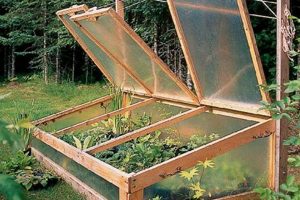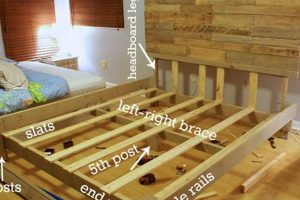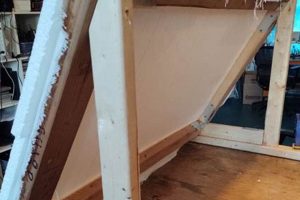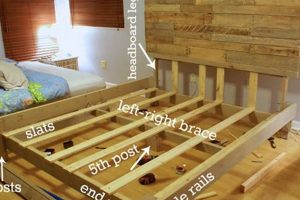A structure, often constructed from wood or repurposed materials, intended to elevate a canine sleeping surface. This allows for increased airflow, potentially reducing dust mite accumulation and providing a more defined space for the animal. An example is a simple rectangular wooden frame built to accommodate a standard-sized dog bed cushion.
The creation of custom canine resting platforms offers several advantages. It enables cost savings compared to commercially available options, promotes creative expression through personalized designs, and allows for tailoring the size and height of the bed to the specific needs of the dog. Historically, elevated animal beds have been used to improve hygiene and comfort, a practice which continues with modern do-it-yourself adaptations.
The following sections will address materials selection, construction techniques, design considerations, and safety precautions relevant to the successful fabrication of a durable and aesthetically pleasing elevated dog resting space.
Construction Guidance
The subsequent guidelines will aid in the creation of a safe and functional elevated canine sleeping area. Adherence to these points will enhance the project’s overall quality and longevity.
Tip 1: Material Selection: Prioritize the use of hardwoods, such as oak or maple, for enhanced durability. If softwood is chosen, ensure proper sealing to prevent splintering and moisture absorption.
Tip 2: Accurate Measurement: Precisely measure the intended sleeping surface dimensions to guarantee a snug fit within the newly constructed support structure. A loose fit can lead to instability.
Tip 3: Secure Fasteners: Employ screws and wood glue for robust joint construction. Avoid reliance on nails alone, as they may loosen over time.
Tip 4: Smooth Surfaces: Sand all exposed edges and surfaces to eliminate sharp corners and potential hazards. A smooth finish reduces the risk of injury to both the animal and the owner.
Tip 5: Elevated Height: Consider the dog’s age and mobility when determining the height of the structure. A lower profile is generally preferable for senior animals or those with joint issues.
Tip 6: Adequate Support: For larger breeds, incorporate additional support beams or a center brace to prevent sagging or structural failure over time.
Tip 7: Non-Toxic Finish: Utilize a pet-safe, non-toxic sealant or paint to protect the wood and prevent the ingestion of harmful chemicals.
The implementation of these strategies will contribute to a stable, comfortable, and safe resting environment for the dog. Meticulous attention to detail during each phase of construction is paramount.
The following segment will provide insights on design aesthetics and customization possibilities to further personalize the finished project.
1. Structural Integrity
Structural integrity, in the context of crafting canine resting platforms, refers to the capacity of the constructed frame to withstand the imposed loads and stresses without deformation or failure. It is a fundamental consideration directly impacting the safety and longevity of the piece. A compromised framework presents a potential hazard to the animal and necessitates costly repairs or replacement.
- Material Selection and Load Capacity
The choice of materials directly influences the load-bearing capability. For instance, using a thin plywood for a large breed dog will result in bowing or collapse. Conversely, hardwoods like oak or maple offer superior strength and resistance to deformation under similar weight conditions. Proper material selection ensures the frame can support the intended load without risk of structural failure.
- Joint Construction and Stability
The method of joining frame components significantly affects overall stability. Weakly constructed joints, such as those relying solely on nails, are prone to loosening and failure under repeated stress. Employing mortise and tenon joints, or using screws and glue, provides a significantly stronger and more durable connection, enhancing the frame’s resistance to racking and collapse.
- Frame Design and Support Distribution
The overall design impacts how weight is distributed across the structure. A simple rectangular frame may require additional internal supports, particularly for larger animals. Incorporating a central support beam or strategically placed cross members helps distribute the load more evenly, preventing localized stress concentrations and minimizing the risk of sagging or breakage.
- Fastener Selection and Application
The type and placement of fasteners are crucial. Using screws of insufficient length or spacing them too far apart compromises the integrity of the joints. Screws should penetrate deeply into the wood and be spaced appropriately to provide maximum holding power. Glue, when used in conjunction with screws, further strengthens the joints and prevents movement that could lead to loosening and failure over time.
These interconnected elements material selection, joint construction, design considerations, and fastener application collectively determine the structural resilience. Prioritizing these considerations during the construction process is essential for delivering a secure and durable canine resting platform capable of withstanding the demands of daily use.
2. Material Safety
Material safety is paramount when constructing canine sleeping platforms. The selected substances must pose no risk of harm to the animal through ingestion, inhalation, or dermal contact. The use of inappropriate materials can result in adverse health effects, necessitating careful consideration throughout the construction process.
- Toxicity of Wood Finishes
Certain varnishes, paints, and sealants contain volatile organic compounds (VOCs) and heavy metals that can be toxic if ingested or inhaled. When applied to a structure intended for animal use, these chemicals can leach out and pose a health hazard. It is crucial to select finishes specifically labeled as pet-safe and non-toxic, ensuring they meet or exceed relevant safety standards.
- Wood Treatment Chemicals
Pressure-treated wood, often used in outdoor construction, contains chemicals designed to prevent rot and insect infestation. These chemicals, such as chromated copper arsenate (CCA), can be harmful if ingested or come into prolonged contact with skin. Avoid using pressure-treated wood in the construction of structures intended for indoor animal use. If used, encapsulate with a pet-safe sealant.
- Potential Allergens
Certain wood species, such as cedar, contain natural oils that can cause allergic reactions in some animals. Similarly, dust from sanding certain materials can irritate the respiratory system. Consider the animal’s sensitivities when selecting materials and take precautions to minimize dust exposure during construction. Opt for hypoallergenic alternatives and ensure proper ventilation.
- Sharp Edges and Splintering Hazards
Even non-toxic materials can pose a physical hazard if improperly prepared. Sharp edges, protruding fasteners, and splinters can cause cuts, abrasions, and infections. Thorough sanding, proper fastener selection, and careful construction techniques are essential to minimize these risks. Regularly inspect the structure for any signs of damage or wear that could create hazards.
The conscientious selection and application of appropriate materials are vital for ensuring the safety and well-being of the animal utilizing the custom-built sleeping platform. Neglecting these considerations can lead to preventable health issues and compromise the intended benefits of creating a personalized resting space.
3. Joint Stability
The structural integrity of a constructed canine sleeping platform is inextricably linked to joint stability. In the absence of robust and dependable joints, the entire structure is compromised, rendering it unsuitable for its intended purpose. The forces exerted by a dog entering, exiting, or resting within the structure are transferred through these joints; thus, their integrity is crucial for long-term durability and safety. A failure in one or more joints can lead to the collapse of the structure, potentially causing injury to the animal.
Examples of joint instability’s impact are readily observable. A frame constructed with loosely fitted dowel joints, secured only with minimal adhesive, is likely to exhibit wobble and eventual failure under even moderate use. Conversely, a frame employing mortise and tenon joints, reinforced with screws and high-quality wood glue, demonstrates superior resistance to stress and maintains its form over extended periods. The practical significance of understanding joint stability lies in the ability to select appropriate joinery techniques based on the size and weight of the dog, the intended use of the structure, and the available materials.
Ultimately, joint stability is not merely a construction detail; it is a cornerstone of the structural soundness of any elevated canine resting platform. Careful consideration of joint design and implementation is essential for ensuring the safety, longevity, and overall success of the construction endeavor. A commitment to robust joint construction directly translates to a safer and more durable product for the animal.
4. Size Appropriateness
Size appropriateness is a fundamental determinant of a successful, custom-built canine resting platform. The dimensions must align with the animal’s physical characteristics to ensure comfort, safety, and usability. A structure that is too small restricts movement and can cause anxiety, while one that is excessively large may fail to provide the desired sense of security. The intended purpose of the elevated surface, whether for sleeping, resting, or providing a secure vantage point, further dictates the requisite dimensions. For instance, a Great Dane necessitates significantly larger sleeping area than a Dachshund.
Consider a situation where a frame is constructed without accounting for the dog’s fully extended sleeping posture. The animal may be forced to contort its body, leading to discomfort, restricted breathing, or even musculoskeletal issues over time. Conversely, an oversized frame might lead to a sense of insecurity, particularly in smaller dogs, negating the intended benefit of providing a defined and secure space. Accurate measurements of the animal in various resting positions are, therefore, paramount. Similarly, the addition of bedding materials must be factored into the final dimensions to ensure an optimal fit and avoid overcrowding.
In summary, size appropriateness is not merely a matter of aesthetics; it is a critical factor influencing the well-being and functionality of a custom-built canine sleeping platform. An understanding of the animal’s specific needs and physical dimensions is essential for creating a structure that is both comfortable and safe. Overlooking this aspect can lead to a product that fails to meet its intended purpose and potentially compromises the animal’s health and comfort.
5. Elevated Height
The vertical dimension, in the context of constructed canine sleeping platforms, directly influences accessibility, comfort, and potential health outcomes for the animal. Optimal elevation is not a fixed value, but rather a variable dependent on the dog’s breed, age, physical condition, and the intended function of the raised surface.
- Accessibility for Aging or Infirm Canines
Elevated height significantly affects ease of access for older dogs or those with mobility limitations, such as arthritis or hip dysplasia. An excessively high platform requires undue exertion, potentially exacerbating joint pain or increasing the risk of falls. Conversely, an insufficient elevation may negate the benefits of an elevated surface, such as improved airflow and reduced dust accumulation. A low profile, easily stepped-onto platform is often preferable for senior animals.
- Air Circulation and Temperature Regulation
Elevation facilitates air circulation beneath the sleeping surface, promoting better ventilation and temperature regulation. By raising the bed off the floor, stagnant air is displaced, reducing the risk of moisture buildup and the proliferation of allergens. This is particularly beneficial in humid environments. The degree of elevation necessary to achieve optimal airflow varies depending on the floor material and the surrounding environment.
- Prevention of Drafts and Protection from Cold Floors
Elevated sleeping platforms provide a barrier against drafts and cold temperatures radiating from the floor. This is especially advantageous in colder climates or in homes with uninsulated flooring. By lifting the bed off the ground, a pocket of warmer air is created, enhancing the dog’s comfort and reducing the risk of hypothermia. Higher elevations offer greater protection from floor-level drafts.
- Ease of Cleaning and Maintenance
Elevating the sleeping surface simplifies cleaning and maintenance. By providing access to the area beneath the bed, dust, debris, and pet hair can be easily removed. This contributes to a cleaner and more hygienic sleeping environment. Higher elevations afford easier access for cleaning, particularly for individuals with mobility limitations. However, excessively high elevations may complicate the process of retrieving items that fall underneath the structure.
Consideration of the aforementioned factors is paramount when determining the appropriate elevation for a custom-built canine resting platform. A well-chosen height contributes to the animal’s comfort, health, and overall well-being, enhancing the value and functionality of the construction project. The selected height should be a deliberate decision rather than an arbitrary one.
6. Surface Finish
The selection and application of a surface treatment to a constructed canine sleeping platform are crucial for both aesthetic appeal and functional performance. The chosen finish directly impacts durability, hygiene, and the overall safety of the environment for the animal.
- Protection Against Moisture and Wear
Untreated wood is susceptible to moisture absorption, leading to warping, cracking, and the growth of mold or mildew. A suitable surface finish, such as a sealant or varnish, creates a barrier against moisture penetration, extending the lifespan of the frame and preventing unsanitary conditions. Furthermore, a durable finish protects the wood from scratches, stains, and other forms of wear and tear associated with regular use.
- Prevention of Splintering and Sharp Edges
Even well-sanded wood can develop splinters over time, posing a risk of injury to the animal. A smooth, continuous surface finish encapsulates the wood fibers, preventing splintering and creating a safer environment. The finish also helps to soften any remaining sharp edges, further reducing the risk of cuts or abrasions.
- Application of Non-Toxic Materials
The selected finish must be non-toxic and safe for animal contact. Many commercially available paints, varnishes, and sealants contain volatile organic compounds (VOCs) or other harmful chemicals that can be ingested or inhaled. It is essential to choose products specifically formulated for pet use, ensuring they meet or exceed relevant safety standards.
- Ease of Cleaning and Maintenance
A smooth, non-porous surface finish simplifies cleaning and maintenance. Spills, stains, and pet hair can be easily wiped away, maintaining a hygienic sleeping environment. Certain finishes also offer resistance to bacterial growth, further enhancing cleanliness. The selection of a finish that is both durable and easy to clean contributes to the long-term usability of the constructed platform.
The integration of these surface finish considerations into the canine sleeping platform project ensures not only an aesthetically pleasing result but also a safe, durable, and hygienic resting space. Careful attention to these details enhances the overall quality and longevity of the construction. The chosen finish should thus be treated as integral to the design.
7. Design Aesthetics
Design aesthetics, when applied to the construction of canine sleeping platforms, represents the intersection of functional requirements and visual appeal. This consideration moves beyond mere utility to incorporate elements of style, form, and compatibility with the surrounding environment. While the primary purpose remains to provide a comfortable and secure resting place for the animal, the integration of thoughtful design elevates the project from a purely practical endeavor to one that also enhances the overall aesthetic of the living space.
The impact of design choices is significant. A poorly designed frame can detract from the room’s decor, while a well-executed design can complement existing furniture and add visual interest. For example, a minimalist frame constructed from reclaimed wood may integrate seamlessly into a rustic-themed home, while a sleek, modern design with clean lines and geometric shapes may be more suitable for a contemporary setting. The selection of colors, materials, and shapes all contribute to the overall visual impact. Ignoring design aesthetics can result in a functional but visually discordant piece, while prioritizing aesthetics alone can compromise the structural integrity and comfort of the frame.
The incorporation of design aesthetics presents challenges, including balancing visual appeal with structural requirements and material costs. However, the practical significance lies in creating a harmonious living environment that caters to both the needs of the animal and the aesthetic preferences of the owner. By carefully considering design elements, a constructed canine sleeping platform can transition from a mere pet accessory to an integral part of the home’s decor. A final challenge lies in balancing affordability and high standards of build quality. Often budget constraints will directly affect the aesthetic outcome.
Frequently Asked Questions
The subsequent questions address common concerns and misconceptions surrounding the construction of elevated canine resting platforms.
Question 1: What is the minimum recommended height for an elevated canine sleeping platform?
The minimum recommended height is contingent upon the breed and age of the dog. A general guideline is to allow sufficient clearance for air circulation beneath the structure, typically around 4-6 inches. However, for smaller or older dogs, a lower profile may be necessary to facilitate easy access.
Question 2: What type of wood is most suitable for frame construction?
Hardwoods such as oak, maple, and birch offer superior durability and resistance to wear. Softwoods like pine or fir can be used, but require proper sealing and may not withstand heavy use as effectively.
Question 3: Are there specific types of fasteners that should be avoided?
Nails alone are generally insufficient for securing joints in a canine sleeping platform. Screws, preferably in conjunction with wood glue, provide a more robust and durable connection.
Question 4: How can the risk of splintering be minimized?
Thorough sanding of all exposed surfaces is essential. Applying a sealant or varnish further encapsulates the wood fibers, preventing splintering and creating a smooth, safe surface.
Question 5: What are the primary safety considerations when choosing a surface finish?
The surface finish must be non-toxic and safe for animal contact. Products labeled as “pet-safe” or “low-VOC” are generally preferable.
Question 6: How can the frame be customized to match existing home decor?
The frame can be customized through the selection of appropriate wood species, stains, paints, and decorative elements. Consider the overall style and color palette of the room when making these choices.
Proper material selection and construction techniques are essential for creating a safe and functional resting platform. Careful attention to detail during each phase of the project will ensure a durable and aesthetically pleasing result.
The following section will provide insights into alternative design options and advanced construction methods.
Conclusion
This exposition has delineated the critical aspects of crafting a “diy dog bed frame.” From material selection and structural integrity to surface finishing and design aesthetics, each element significantly influences the functionality, safety, and longevity of the finished product. The discussion emphasizes the importance of tailoring the construction to the specific needs of the animal, considering breed, age, and physical condition.
The creation of a custom canine sleeping platform represents a valuable opportunity to provide a comfortable and secure resting environment while aligning with individual aesthetic preferences. Diligent adherence to the outlined guidelines will maximize the likelihood of a successful outcome, promoting the well-being of the animal and enhancing the overall living space. Careful planning and execution are essential for realizing the full potential of this endeavor.







